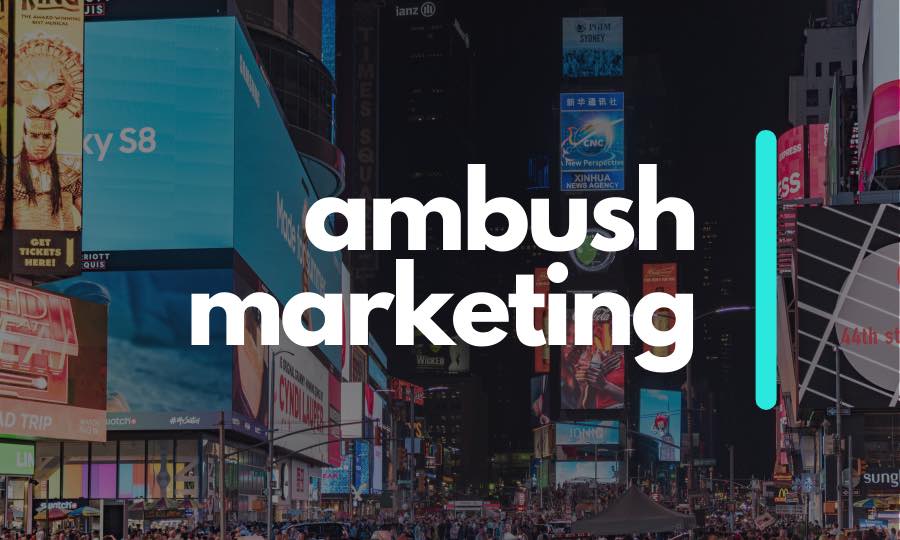What is Ambush Marketing and What Are Its Advantages and Disadvantages?
Ambush Marketing is quite a famous style of modern day marketing. It’s used by a number of brands (including some of the most prestigious ones) all over the world. While their success or failure can not truly be measured, but ambush marketing campaigns always end up being very memorable. In this post, we will discuss about what ambush marketing is, some of its best examples and the advantages and disadvantages of it. Let’s start the ambush.
Table of Contents
What Is Ambush Marketing?
Ambush marketing, also known as predatory ambushing or coat-tail marketing is a marketing style where a company hijacks or co-opts another company’s advertising campaign in order to promote itself, usually at the expense of the other one.
One of the classic cases of ambush marketing is the feud that erupted between American Express and VISA during the 1992 Winter Olympics in Albertville, France.
Having paid $20 million (approximately $35.5 million in today’s money) for the privilege, VISA became the official credit card sponsor for the 1992 Winter Olympic Games. For months prior to games, VISA ran TV commercials advising American Express cardholders to leave their American Express cards at home as “the Olympics don’t take American Express.”
The ad soon became one of the most controversial ads of its time. Technically, this was true. All of the tickets for the games could only be purchased with VISA credit cards. However, VISA’s aggressive ad campaign soon raised the ire of American Express, which claimed VISA’s ads were purposefully misleading by suggesting that American Express cards were not accepted anywhere during the 1992 Winter Olympic Games. American Express was furious that VISA made it look like American Express cards won’t work anywhere in Albertville when it were only the ticket sellers who went VISA exclusive.
American Express soon launched its own series of TV spots, which featured the slogan, “When you go to Spain, you’ll need a passport – but you don’t need a Visa,” a sly reference to the forthcoming Summer Games in Barcelona and a subtle dig at the company’s rival. In the ensuing fallout, VISA accused American Express of engaging in “parasite marketing”. That term was later refined and renamed as the more palatable ‘ambush marketing’. Let’s take a look at another quirky and famous real-world example of ambush marketing.
The infamous BMW vs. Audi ambush marketing battle of Santa Monica
Santa Monica, California is famous for its beautiful beaches, piers and glorious weather. However, this rich coastal town was also the battleground upon which two teutonic titans of car manufacturing, BMW and Audi, engaged in an ambush marketing bloodbath.
The seeds of discord were sown after (not like there was any love lost between the two before that) BMW held a rally in the midwestern state of Wisconsin. The rally was promoted via a marketing campaign whose slogan was “A BMW rally with two nearby service centers. What’s next, paramedics at a chess tournament?”
Audi saw this as an opportunity to capitalize upon BMW’s slogan. Audi purchased a billboard in Santa Monica and put up an ad of its brand new A4 sedan while mocking BMW’s slogan:
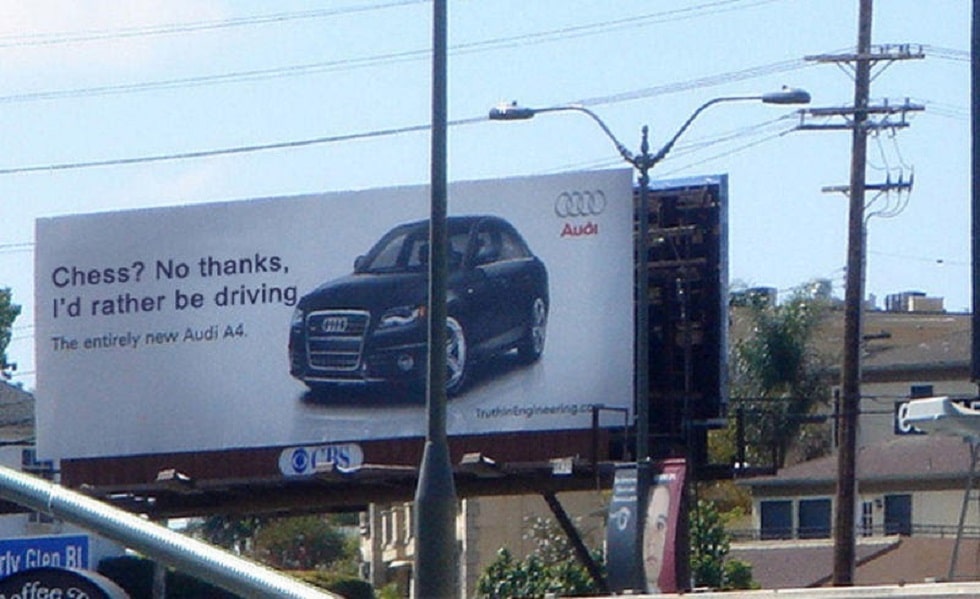
That single billboard wasn’t enough for Audi. It doubled down on its stance and put up another billboard to mock BMW’s nonsensical chess theme:
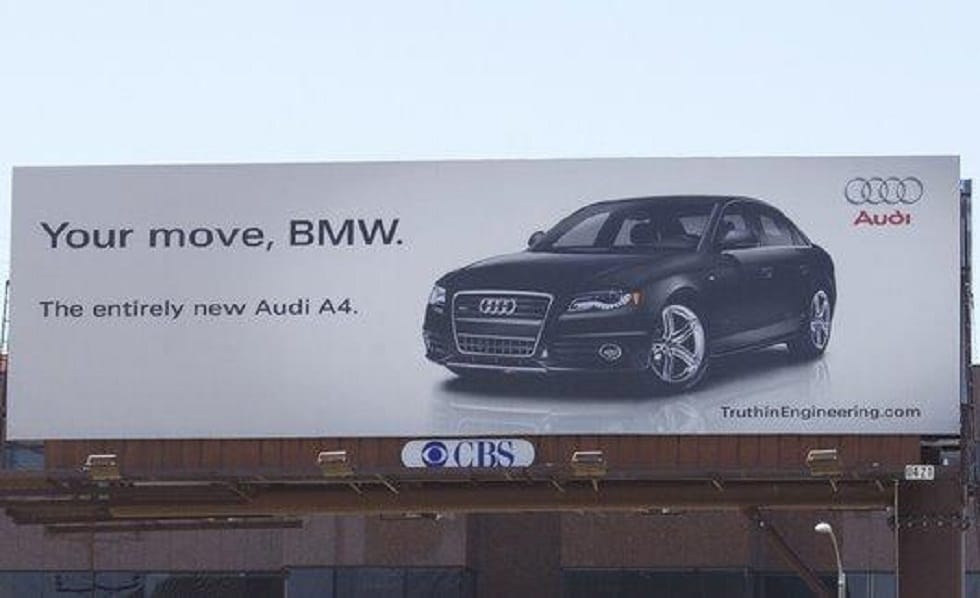
BMW wasn’t going to just go gently into the night, or turn the other cheek. In retaliation, BMW purchased a billboard across the street from the Audi billboard and fought back with a chess themed response:

But that wasn’t the end of it, Audi responded with a billboard featuring its R8 supercar. Even after that, the German giants didn’t stop. BMW promptly bought a blimp with The image of a BMW Formula 1 car and put it up as a response to the Audi R8. And to add insult to injury, BMW tethered the F1 car blimp to the Audi R8 billboard:
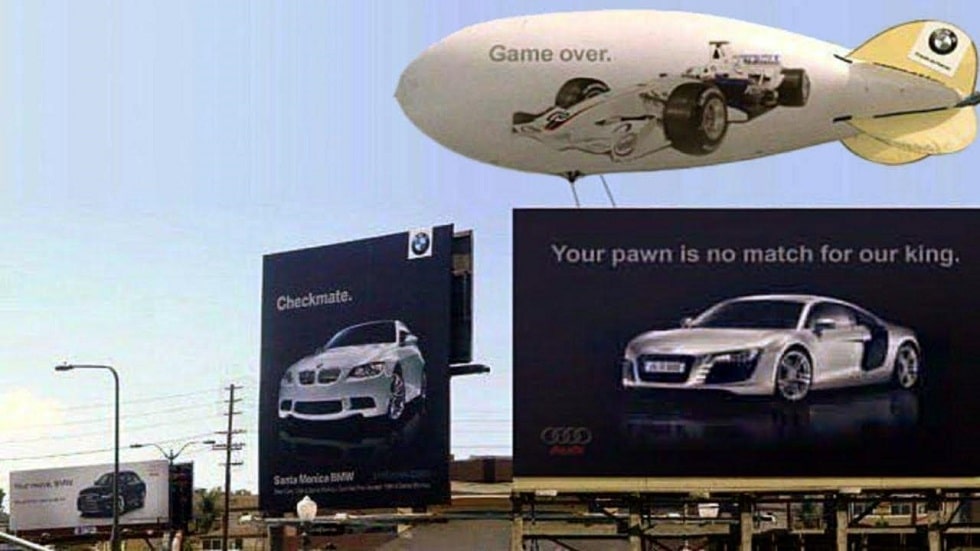
Now that you have seen a hilarious example of ambush marketing, let’s take a look at the advantages and disadvantages of it.
Advantages of ambush marketing:
Now that you have a basic idea of ambush marketing, let’s take a look at the advantages of such a marketing style.
Ambush marketing tends to be very clever
Ambush marketing campaigns tend to be extremely flexible with creativity and as a result, can produce some really cheeky and humorous results.
In general, most ambush marketing campaigns are a direct response or an attempt at leveraging an existing marketing campaign of a competitor. Because of that, ambush marketing campaigns end up being extremely creative. The creativity is expressed in the form of fantastic visual trickery or cheeky wordplay. This makes ambush marketing campaigns far more entertaining and clever than regular ads, and as a result, more memorable.
An integral part of the success of ambush marketing are sly jokes and subtle references. Ambush campaigns are usually crafted as a direct response to one another, as elucidated by the BMW vs Audi example we discussed above. This results in visual humour transforming into critical competitive edge.
When ambush marketing campaigns go head to head, the more clever and humorous ad will always be more memorable.
Ambush marketing don’t necessarily follow a script
When it comes to display advertising, online or in real life, cohesion is crucial. Whether the ad is on a gigantic Times Square billboard or on the back of an in-flight magazine, brands ensure that the advertising campaign’s look and feel stays consistent. Ambush campaigns, however, can get a little more creative.
Ambush marketing allows brands the freedom of going away from the script of usual advertising campaigns (in content, style and tone). Brands frequently use techniques that are generally beyond the scope of their usual advertising guidelines. This results in a lot of creative freedom and flexibility.

This concept was leveraged very skillfully by famous Italian car make Fiat when it launched an impromptu ambush marketing campaign in 2013 when Fiat somehow managed to park a red Fiat 500 hatchback car on the front steps of Volkswagen’s Swedish headquarters – just in time for a Google Maps car to pass, which preserved Fiat’s little stunt for years in Google Maps results. (The offending little red Fiat is no longer immortalized in Maps results, as Google refreshed the old image with a newer image that was taken in June of 2017).
Ambush marketing changes the perceptions of consumers
When done well, ambush marketing helps the brand cultivate and display new and different brand values and attributes to the consumer.
South African airline Kulula’s ads in 2010 are a great example of that. To coincide with the 2010 World Cup, Kulula launched an ad campaign branding itself as the “Unofficial National Carrier of the You-Know-What,” a not-so-subtle reference to the forthcoming soccer tournament. However, the World Cup’s governing body, FIFA clamped down on the advertisement and said that the ads were launched “to gain a promotional benefit for the Kulula brand by creating an unauthorized association with the 2010 FIFA World Cup.”
Though unhappy with FIFA’s decision, Kulula reluctantly complied with FIFA’s order. However, the airline wasn’t done quite yet. Shortly after the ads were pulled, Kulula said it would fly anyone named Sepp Blatter – the name of FIFA’s then-president – for free.
In the end, the airline company found a Boston Terrier named Sepp Blatter (erstwhile FIFA President) and made it the firm’s unofficial mascot.
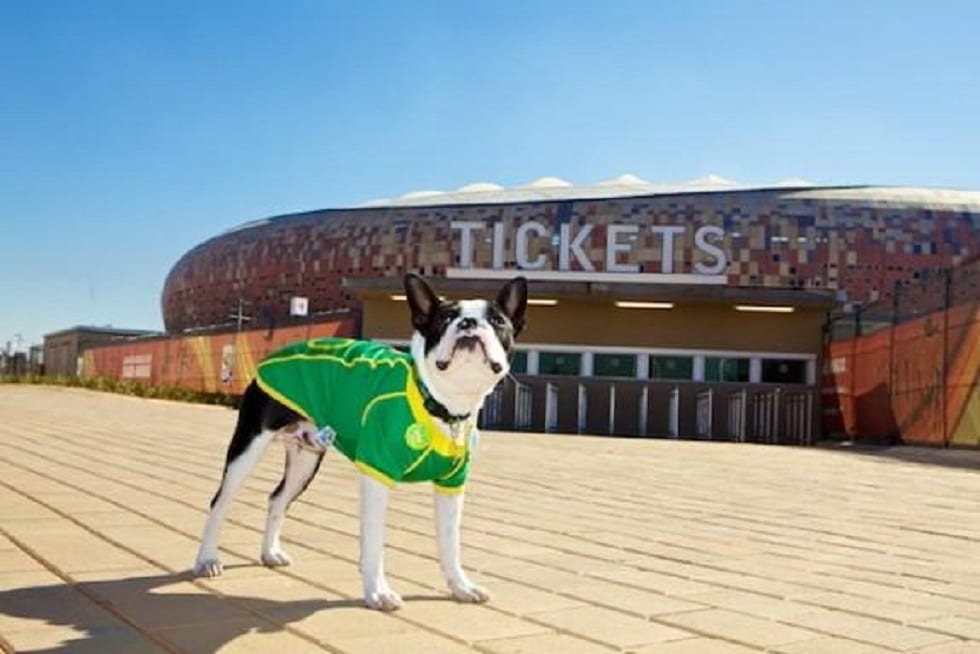
Kulula’s campaign was a great example of an ambush marketing campaign cultivating new brand values. Air travel is an insanely competitive industry, but Kulula’s ambush campaign not only gained the airline some invaluable publicity, but also advanced the idea that Kulula isn’t just another dry, boring airline.
Disadvantages of ambush marketing
As with everything else in life, ambush marketing has both advantages and disadvantages. Since we have already looked at the former, let’s look at the latter now.
Ambush marketing is usually quite expensive
Quite possibly the biggest drawback of ambush marketing is its potential of becoming very expensive in the end.
The aforementioned BMW vs Audi ambush marketing campaign in Santa Monica, California is a great example. Let’s assume that each billboard in that area costs $10,000. The fight between the two firms lasted for months and as a result, four separate billboards were erected in the same area (that would’ve added to the cost). On top of that, BMW went on to put a blimp on one of the billboards. The blimp alone would’ve cost more than half a million dollars. Add the design and production costa and we are talking about an extremely expensive affair.
Not exactly small change.
Return on Investment (ROI) for ambush marketing campaigns is very tough to calculate
Calculating the return on investment (ROI) of an ambush marketing campaign is generally extremely difficult, if not entirely impossible altogether. The amount of cars that BMW would’ve needed to sell to just recover the cost of the blimp is very high. So there is no way to gauge if its ambush marketing wars with Audi provided good returns on the money invested (the same applies to Audi as well).
Ambush marketing is heavily dependent on time and space
Aside from the potentially massive costs involved with ambush marketing, the campaigns also depend on a quick response and co-ordinated planning for its success. The situation is exacerbated by the lack of availability or extremely high costs of the inventory needed to put the ad up.

